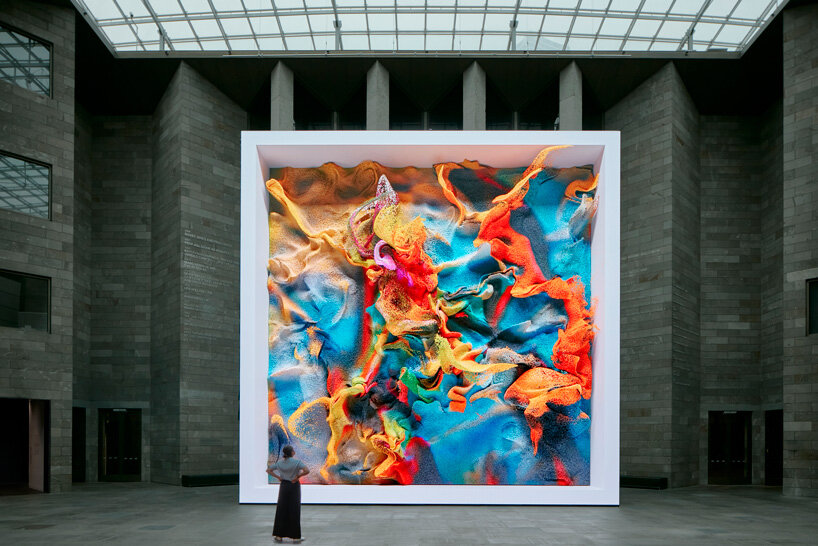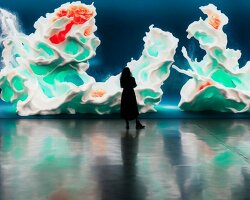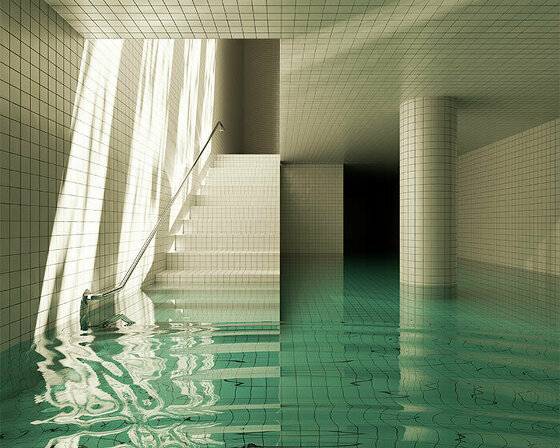‘NFTS AND PUBLIC ART’ AT NFT ART DAY ZRH
NFT ART DAY ZRH, the first annual NFT and metaverse conference in Switzerland, brought together leading figures from the field of digital arts and the art market for an insightful afternoon of talks. Participants explored different topics related to NFTs, including an introduction to non-fungible tokens and their relationship to the art world, as well as the collecting behavior and various artistic practices around them. One of the topics of the conference was dedicated to NFTs and Public Art, which was addressed through a conversation between Refik Anadol, media artist, director and pioneer in the aesthetics of data and machine intelligence, and Hans Ulrich Obrist, artistic director of the Serpentine Galleries. The two speakers discussed Refik Anadol’s oeuvre over the past years working with the medium of NFTs, and what it means to employ blockchain technology to create public artworks.
As media partner of NFT ART DAY ZRH, designboom brings you selected interviews and news from the conference’s inaugural edition. Following our interview with Katharina De Vaivre and Georg Bak, the conference’s co-founders, and with conceptual crypto-artist Kevin Abosch, we reached out to Refik Anadol and Hans Ulrich Obrist to find out more about the relation between NFTs and public art, as well as other themes their conversation addressed. ‘Landmarks and public squares become his canvas and he shows us possibilities for new hybrid architecture,’ Hans Ulrich Obrist tells designboom while talking about Refik Anadol’s use of blockchain technology for new public art. ‘Refik has a holistic approach that goes beyond the restrictive binary of physical and digital.’ Read our conversation with the two NFT ART DAY ZRH speakers in full below.

Refik Anadol and Hans Ulrich Obrist | image courtesy of NFT ART DAY ZRH, photo © Shkelzen Konxheli
header image: Refik Anadol, Quantum Memories at NGV Triennial | read more on designboom here
all images © Refik Anadol Studio, unless stated otherwise
INTERVIEW WITH hans ulrich obrist + REFIK ANADOL
designboom (DB): What, in your opinion, is the most fascinating aspect of Refik Anadol’s artistic practice?
Hans Ulrich Obrist (HUO): As Zaha Hadid – who is one of Refik’s inspirations – told me, there should be no end to experimentation. Refik’s experiments with technology and blockchain have always had a collaborative focus.

Refik Anadol, Quantum Memories at NGV Triennial | read more on designboom here
DB: Which specific topic within the field of NFTs did your conversation address?
HUO: His practice is decentralised, generative and often has a charity dimension. It has what Marianna Mazzucato calls a mission economy at heart. Refik’s work raises some of the key questions such as: can a machine learn? Can it dream, can it hallucinate? His consequent work with archives where he splits AI algorithms to archives, shows us the future is invented with fragments from the past.
Another important aspect is how he uses blockchain for new public art. Landmarks and public squares become his canvas and he shows us possibilities for new hybrid architecture. Refik has a holistic approach that goes beyond the restrictive binary of physical and digital. The conversation addressed all these many dimensions of his practice. We also discussed gaming and his video game project, and my interest in games and world building. The Julia Stoschek exhibition I curated explores the relationship between gaming and time-based art. I also invite you to read more on Gabriel Masan projects.
DB: You were one of the first people working with ‘data painting’. Can you explain what it is about and how you incorporate it into your work?
Refik Anadol (RA): I coined the terms AI Data Painting and AI Data Sculpture to describe site-specific three-dimensional, dynamic sculptures at the intersection of architecture, media art, light studies, and AI-based data analysis. I envisioned AI Data Paintings moving beyond the integration of media into built forms, translating my logic of a new media technology as well as my vision of post-digital architecture into spatial design. In 2008, during my last year of undergraduate studies in Istanbul I took a very inspiring lecture course on a software called PureData by Koray Tahiroglu, a wonderful artist and a professor at Aalto University. The software was developed primarily for sound artists but it also displayed an inspiring visual computing capacity. It was in that class that I coined the term Data Painting by simply plotting series of sensors mostly used in physical interaction design. I also took a deep dive into VVVV, a software that I have been using in almost all of my real-time projects since 2008. It provides an incredible community and visual programming language that can be used without any single line of code. Later in 2012, during my studies at the UCLA, I explored processing and began working on Data Paintings and Sculptures thanks to Casey Reas, a pioneer in the field and a wonderful mentor who changed my entire perception of generative art.

Refik Anadol Studio, AI Data Painting
DB: Stepping outside of the art world, do you think your methods of ‘data painting’ have the potential to be beneficial for science and other aspects of humanity?
RA: Wishfully thinking, yes. This question has been very important for our research into neuroscience, nature, and architecture, especially during the pandemic. We believe that immersive and multisensory spatial experiences, when combined with meaningful and cutting-edge data visualization techniques, can create a healing power. There are countless medical studies in progress about the use of gaming technologies and multimedia for pain management as well. There is infinite creative potential in machine algorithms that can take various shapes for the advancement of humanity. We have been researching wellbeing aspects of our works in collaboration with UCLA Neuroscientists since 2020. We also collaborate with scientists at Harvard and UCLA to create tools for them for better data visualization that will aid their research in the long run.

Refik Anadol, Machine Hallucination at ARTECHOUSE | read more on designboom here
DB: Why do you think NFTs are particularly popular in the arts?
RA: In the blockchain world, art operates in a decentralized way, that is, without the presence of a value-giving gallery patron. It is an innovative system with the potential to adapt to change through smart contracts. I think that all this transparency has had positive results, especially for digital artists who find it difficult to find a place for themselves in the traditional gallery world. I find this aspect very inspiring. It has the potential to revolutionize the digital art world. It also allows innovative creators to program their smart contracts for dynamic artworks, imagine new ways of presenting generative art, and create meaningful and purposeful charity projects. Our latest NFT collection allowed us to donate $2.5M for St. Jude Children Hospital, and the success of this fundraising project covered the entire cost of an operation day at the hospital to support the families and children.

Refik Anadol, Machine Memoirs: Space at Istanbul Pilevneli Gallery
DB: Do you see any negative aspects in NFT artworks and the way we experience them?
RA: As an active participant in this world, I constantly reevaluate my own position and make inferences about the social and environmental dimensions of the NFT phenomenon. Of course, as in every new structure, there are whales and sharks in this ecosystem as well. I always worry that the positive aspects of this phenomenon will be shadowed by those who might use it negatively or selfishly – by neglecting collectivity, humanity, charity, or the environment. My team and I are doing significant work for protecting the environment and creating more meaning and value for the system with every NFT collection we prepare.

Refik Anadol, Machine Hallucination at ARTECHOUSE | read more on designboom here
DB: What do you think about the metaverse and its impact on the NFT market?
RA: At the moment anything is open to imagination and I’m pretty sure that many creators are building their own architected meat verses. We are also building our own one, called the DATALAND! It will be the world’s very first multi-sensory Metaverse project, marking a turning point in the aesthetic convergence of virtually enhanced physical and augmented reality. It also bring together the world’s leading neuroscientists, AI and computer graphics pioneers, olfactory and real-time biosensing technologies as well as collaborations with innovation leaders. We think that DATALAND will have impact beyond the creative communities of the digital world and create value for any people.

Refik Anadol, Machine Hallucination at ARTECHOUSE | read more on designboom here
DB: What do you hope visitors will take away from your talk at NFT ART DAY ZRH?
RA: As a protagonist in my field, I’ll do my best to bring to the surface the positive potential impact of the medium I am working with, share the outcomes of experimental and experiential aspects of NFT Public Art to bring hope and inspiration to the discourse. I have had the privilege of exchanging incredible ideas with Hans Ulrich Obrist and his vision and guidance always allow us to create more insightful views of recent innovations.

inside Refik Anadol Studio | image by Kyle Raymond Fitzpatrick

image by Kyle Raymond Fitzpatrick

Refik Anadol and Hans Ulrich Obrist | image courtesy of NFT ART DAY ZRH, photo © Shkelzen Konxheli
project info:
conference name: NFT ART DAY ZRH
location: Auditorium Kunsthaus Zürich
date: 12 June 2022
participants: Kevin Abosch, Refik Anadol, Georg Bak, Erick Calderon, Primavera De Filippi, Alex Estorick, Patrick Foret, Sarah Friend, Jonathan Ledgard, Anika Meier, Hans Ulrich Obrist, Penny Rafferty, Markus Reindl, Margit Rosen, Laurent Sauveur, Kenny Schachter, Paul Seidler
NFT ART DAY ZRH is a collaboration between E.A.T. / Engadin Art Talks and Tokengate. It aims to spotlight crypto art within the wider realm of the history of digital art, whilst building bridges with the art world. NFT ART DAY ZRH envisions a series of conferences and other gatherings that focuses on the relationship between art and NFTs, through the innovation of blockchain technology, historical digital art since 1950s, its market performance, and other components of this complex ecosystem.
ART INTERVIEWS (119)
DIGITAL ART (126)
NFT (NON-FUNGIBLE TOKEN) (101)
NFT ART DAY ZRH (7)
PUBLIC ART (597)
REFIK ANADOL (19)
PRODUCT LIBRARY
a diverse digital database that acts as a valuable guide in gaining insight and information about a product directly from the manufacturer, and serves as a rich reference point in developing a project or scheme.


























